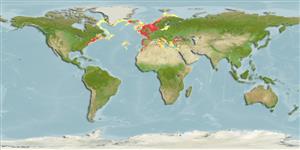Classification / Names
Common names from other countries
Main reference
आकार / वज़न / Age
Max length : 60.0 cm FL पुल्लिंग / अलिंग; (Ref. 35388); common length : 30.0 cm FL पुल्लिंग / अलिंग; (Ref. 168); अधिकतम प्रकाशित वज़न: 3.4 kg (Ref. 9988); अधिकतम सूचित उम्र: 17 वर्षो (Ref. 207)
Length at first maturity
Lm 28.7, range 34 - ? cm
पर्यावरण
; समुद्री; खारा; औशिनोड़िरोमस (Ref. 51243); गहराई सीमा 0 - 1000 m (Ref. 54254), usually 0 - 200 m (Ref. 54254)
जलवायु / सीमा
Temperate, preferred 10°C (Ref. 107945); 70°N - 25°N, 77°W - 42°E
वितरण
Short description
पृष्ठीय रीढ़ (सम्पूर्ण): 8 - 14; पृष्ठीय सौफट रेज़ (सम्पूर्ण): 113; गुदा कांटा 1; ऐनल सौफट रेज़: 12 - 13; जानवरों की रीड़ का जोड़: 31. This species has the following characters: no well developed corselet; interpelvic process small and single; anal fin spine conspicuous, joined to the fin by a membrane but clearly independent of it; anal fin origin opposite that of second dorsal fin; no swim bladder; first haemal spine anterior to first interneural process; 21-28 interneural bones under first dorsal fin; markings on back oblique to near vertical, with relatively little undulating; belly unmarked (Ref. 168).
IUCN Red List Status (Ref. 115185)
Threat to humans
Harmless
Human uses
मात्स्यिकी: उच्च वाणिज्य; आखेट मत्स्य: हां
साधन
Special reports
Download XML
इंटरनेट स्रोत
Estimates of some properties based on models
Phylogenetic diversity index
PD50 = 0.5625 many relatives (e.g. carps) 0.5 - 2.0 few relatives (e.g. lungfishes)
Trophic Level
3.6 ±0.2 se; Based on diet studies.
लौटाव
माध्यम, न्यूनतम जनसंख्या दुगनी होने का समय 1.4 - 4.4 वर्ष। (rm=0.33-0.56; K=0.23-0.27; tm=2-3; tmax=17; Fec=200,000)
Vulnerability
Moderate vulnerability (44 of 100)
Price category
